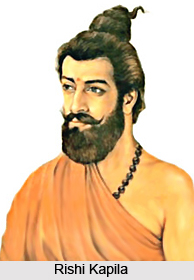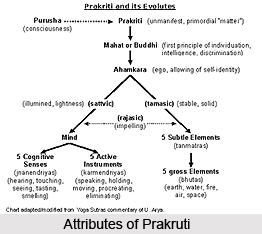 Ayurveda constitutes not just science but also the philosophy and religion. Religion implies the disciplines and beliefs which contribute towards a state of being in which one can perceive all the aspects of life. According to the concepts of Ayurveda, the entire journey of life is considered sacred. Philosophy indicates the love for truth and truth in Ayurveda is the pure existence of a person. Thus the science of truth constitutes Ayurveda which finds its expression in life.
Ayurveda constitutes not just science but also the philosophy and religion. Religion implies the disciplines and beliefs which contribute towards a state of being in which one can perceive all the aspects of life. According to the concepts of Ayurveda, the entire journey of life is considered sacred. Philosophy indicates the love for truth and truth in Ayurveda is the pure existence of a person. Thus the science of truth constitutes Ayurveda which finds its expression in life.
Samkhya philosophy of creation forms the basis of all the Ayurvedic literature. The term Samkhya is formed of two Sanskrit words `sat` which means truth and `khya` which means to know. The readers of Ayurvedic literature are advised to cultivate an open mind and heart to grasp the philosophy of Samkhya owing to its intimate connection with Ayurveda. In ancient times the truth were discovered by sages with the help of religious practices and disciplines. They had inculcated truth in their daily lives through intensive meditation. Ayurveda encompasses the science of daily living which has evolved from religious, philosophical and practical illumination. This system of knowledge is enrooted in their understanding of the creation. On the basis of the intimate relationship between the man and the universe they had also developed an understanding about the manifestation of cosmic energy in all living as well as non living organisms. The sages had also realized that cosmic consciousness is the source of all existence, the manifestation of which is male and female energy known as Shiva and Shakti.
 The Samkhya philosophy of creation was realized by Rishi Kapila who had also discovered twenty-four elements or principles of universe. The most basic of these is Prakruti, also known as creativity. Prakruti signifies the female energy while Purusha is the male energy. The latter is colourless, formless and devoid of attributes. It also does not take any active part in the creation of universe. It is a passive awareness devoid of choice. In contrast, Prakruti has colour, form as well as attributes and implies awareness with choice. It indicates a divine will which desires to become many. It is believed that the universe is a child which has taken birth from the womb of Prakruti, also known as the Divine Mother. All forms of universe are created by Prakruti whereas Purusha witnesses the creations.
The Samkhya philosophy of creation was realized by Rishi Kapila who had also discovered twenty-four elements or principles of universe. The most basic of these is Prakruti, also known as creativity. Prakruti signifies the female energy while Purusha is the male energy. The latter is colourless, formless and devoid of attributes. It also does not take any active part in the creation of universe. It is a passive awareness devoid of choice. In contrast, Prakruti has colour, form as well as attributes and implies awareness with choice. It indicates a divine will which desires to become many. It is believed that the universe is a child which has taken birth from the womb of Prakruti, also known as the Divine Mother. All forms of universe are created by Prakruti whereas Purusha witnesses the creations.
Prakruti is primordial physical energy which comprises three attributes, also known as gunas, which is existent in all nature. These three gunas constitute tamas (inertia), rajas (movement) and satva (essence) which forms the foundation of all existences and are duly balanced. With the disturbance of this balance the gunas interact, endangering the evolution of the universe. Cosmic intellect is the first manifestation from Prakruti. Ego or Ahamkar originates form Mahad or intelligence and the former, with the aid of satva, then manifests into the five senses, called tanmatras, and the five motor organs and create the organic universe. This ego also manifests five basic elements, called bhutas, with the aid of tamas for creating the inorganic universe.
Another vital active force in the body is Rajas which moves both inorganic and organic universes to tamas and satva respectively. Thus the tamas and satva can be considered as inactive potential energies which require the active, kinetic force of rajas. Satva signifies creative potential (Brahma), rajas denotes a kinetic protective force (Vishnu) and tamas corresponds to the potential destructive force (Mahesha). These three are believed to be the three manifestations of `aum`, the first cosmic soundless sound that continuously operates in the universe.





